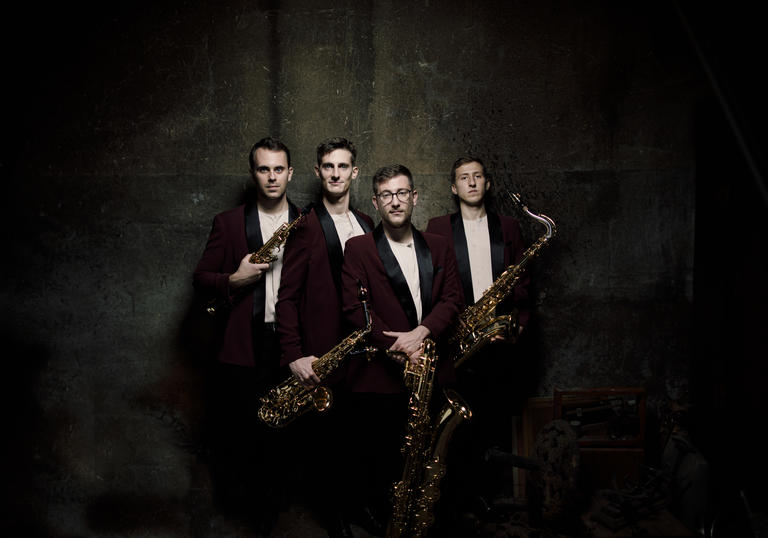Invented by Adolf Sax during the early 1840s, the saxophone was initially more enthusiastically, and successfully, embraced in jazz music, and its ambition of unqualified acceptance into the classical arena has consequently been hamstrung by a seemingly irreconcilable jazz versus classical paradox.
Even though the symphonic repertoire abounds with exquisite solos like those in Rachmaninov’s Symphonic Dances and Gershwin’s An American in Paris – and Glazunov’s Concerto for alto saxophone of 1934 remains enduringly popular – and despite many familiar 20th-century composers, including Hindemith, Villa Lobos, and Milhaud having composed for the instrument, the saxophone has lacked outstanding advocates on the scale enjoyed by other woodwind, and brass instruments.
But every now and then the musical world is blessed with an individual, or an ensemble, that is committed to addressing that injustice. The members of Kebyart Ensemble are keen to assume that responsibility, and they are determined to 'offer a fresh perspective on traditional classical performance'.
Formed in 2014, Kebyart Ensemble derives its name from kebyar, a genre of Balinese gamelan music in which the unique virtuosity and energy of the music creates a kind of ecstasy in the community. It is this ecstasy that the four saxophonists of Kebyart Ensemble wish to stimulate in their audiences. And they also hope to enable the saxophone quartet as a genre to achieve the level of prominence and significance during the 21st Century that the string quartet enjoyed during the 19th. Named European Concert Hall Organisation rising stars for 2021/2022, Kebyart Ensemble will during the coming season perform under its auspices in major concert venues across Europe and the UK.
The ensemble begins its programme today with a selection of six movements from Stravinsky’s iconic Pulcinella Suite, arranged for saxophone quartet by Kebyart Ensemble itself: Overture, Serenata, Tarantella, Toccata, Menuetto and Finale. Robert Seara, the ensemble’s tenor saxophonist, characterises all their arrangements as a collective endeavour, with each member contributing freely, in a spirit of genuine camaraderie. Kebyart Ensemble’s Pulcinella arrangement boldly seeks to articulate a 21st-century expression of Stravinsky’s music, which is itself a 20th-century view of music from the 18th Century, by Giovanni Battista Pergolesi.
The repertoire of original chamber music compositions for saxophone quartet by internationally recognised composers is relatively meagre, with Glazunov’s quartet Op 109 of 1932 being the most notable in the genre. But Florent Schmitt’s Quatuor Pour Saxophones Op 102 of 1948 is, alongside Glazunov’s, one of the seminal works in the repertoire, and one with which Kebyart Ensemble feels a natural affinity. Schmitt was part of the group of composers known as Les Apaches, and although he is sometimes disparagingly referred to as one of the most fascinating of France’s lesser-known classical composers, Schmitt enjoyed the confidence of Stravinsky.
This delightful four movement quartet is one of three works Schmitt composed for saxophone quartet. It is a cornerstone of the ensemble’s repertoire and constitutes a major part of their programme today. Though fundamentally impressionistic and romantic stylistically, the outer movements of the quartet are essentially contrapuntal. The rhythmically challenging second movement, with its plangent alto saxophone melody, scampers around virtuosically, and the third movement presages Stravinsky's harmonic language.
In common with many of its predecessors and competitors, Kebyart Ensemble is committed to enlarging the repertoire for saxophone quartet not just with its own arrangements, but through contemporary music commissions as well.
Jörg Widmann’s 7 Capricci, enabled by the support of Palau de la Música Catalana, l’Auditori de Barcelona, and the European Concert Hall Organisation, is the ensemble’s most recent, prestigious, and treasured commission. Jörg Widmann is himself a clarinettist, and the ensemble believes that his depth of knowledge of the finer nuances of woodwind playing has enabled him to compose a work that is not only uniquely tailored to the ensemble’s own strengths, but also magnificently exploits the capabilities of the four saxophones. Widmann describes his composition thus: 'The result is now seven “moods”, i.e., capricci; short, very different pieces that explore the possibilities of four saxophones: from the opening chromatic quarter-tone “Ascensió” to two noise pieces, a waltz, two chorales to the final “circus parade”, from holy seriousness to exuberant comedy.'
Then in an ‘innocent ear’ challenge, without identifying which is which, the ensemble will perform its own arrangements of two songs without words each by Felix and Fanny Mendelssohn, leaving the audience to decide which is which. Kebyart Ensemble hopes that their audience will then more objectively reconsider its understanding of the history of music itself. Why has Felix Mendelssohn's music been more readily embraced than that of his sister?
And to conclude proceedings, Kebyart Ensemble presents its own thoroughly personal view of Leonard Cohen’s musical adaptation of Federico Garcia Lorca’s poem, Pequeño Vals Vienès – a mixture of Cohen and Kebyart fantasy.
© Leon Bosch

